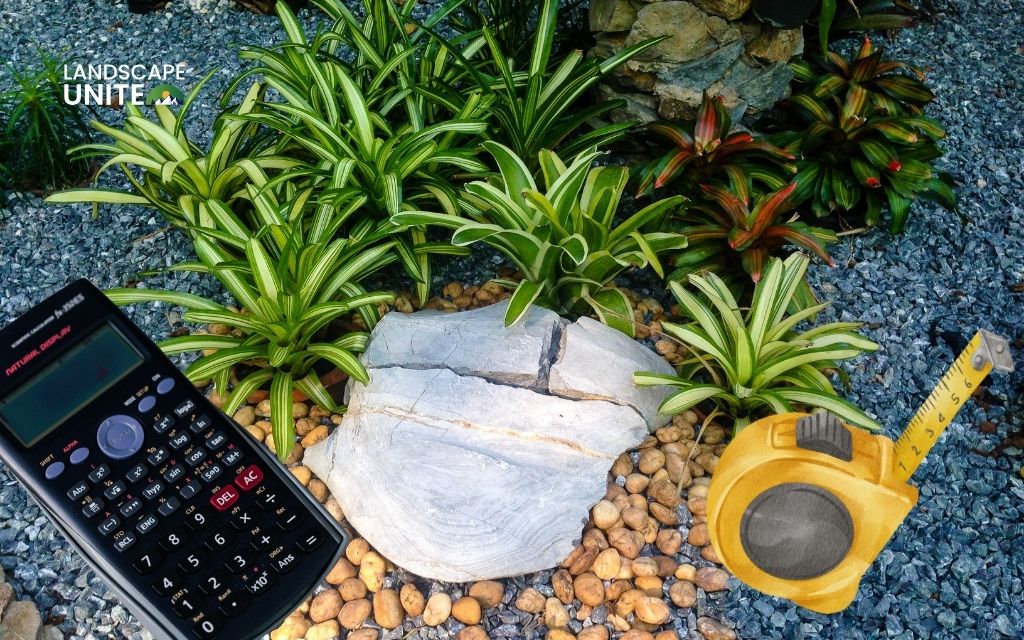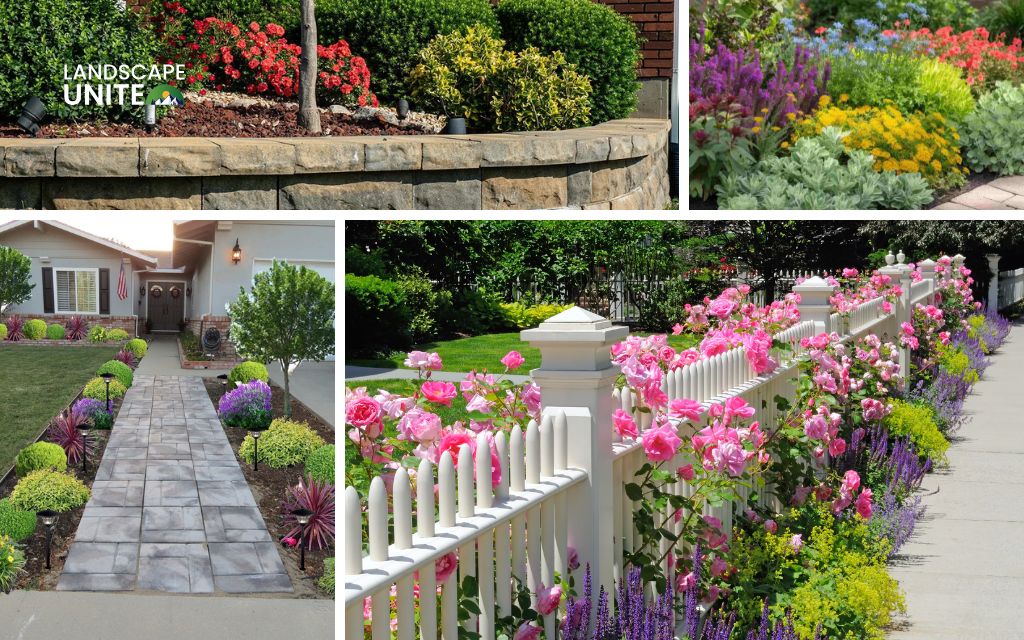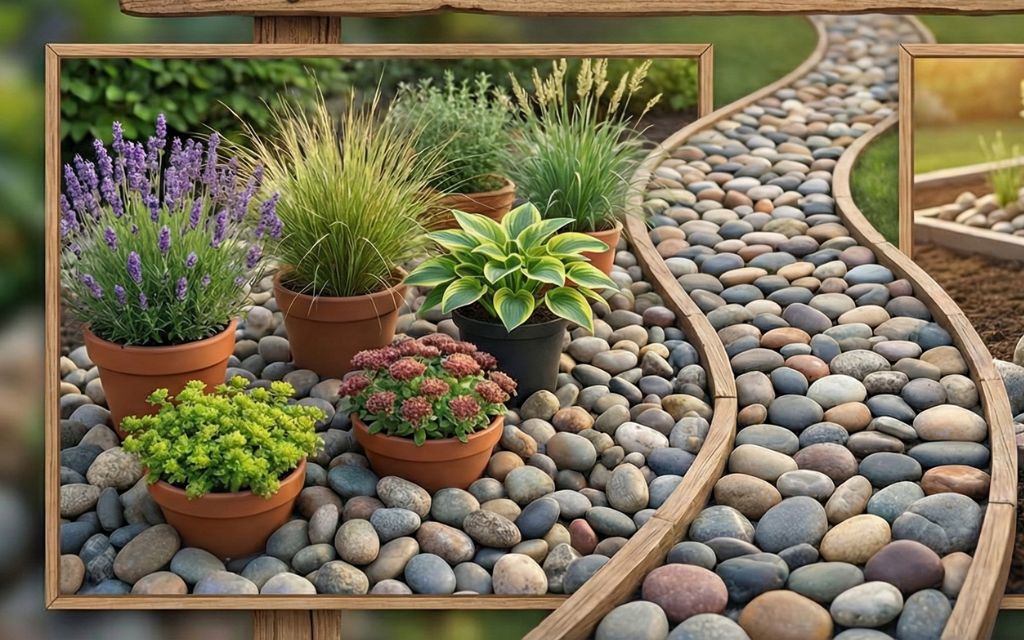Turning a slope into a beautiful flower bed might seem intimidating at first glance but with the right design and strategic planning, it can become the most stunning and memorable feature of your entire landscape.
This comprehensive guide will walk you through practical, creative ideas for transforming your flower bed on slope into a thriving garden showcase. You’ll discover proven structural solutions, smart plant selections for stability and color, and design inspiration tailored to every type of hillside.
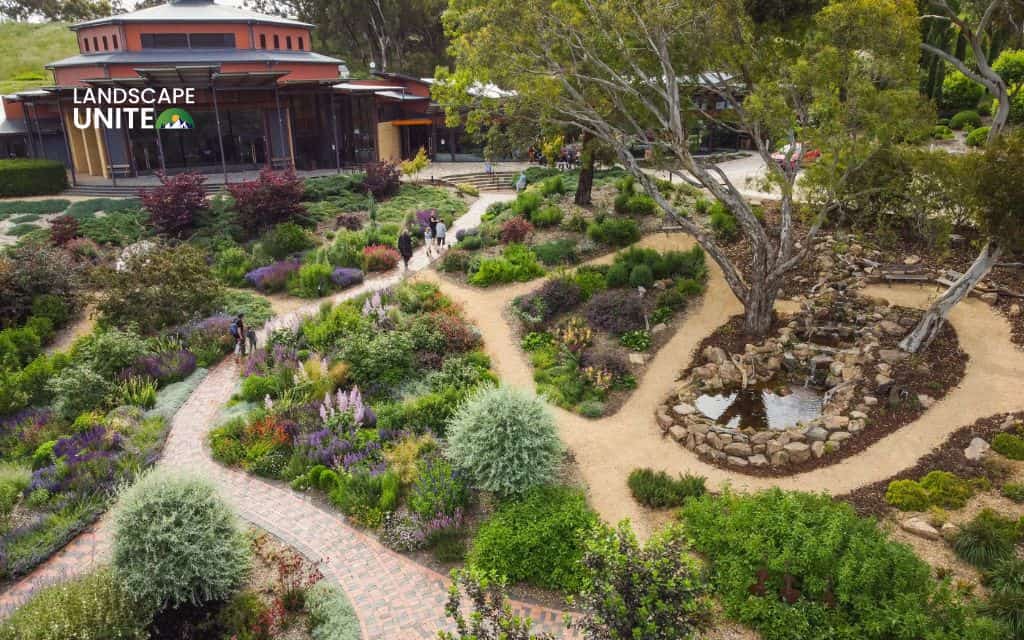
The challenge of planting on a slope
Before diving into solutions, it’s important to understand why planting flower beds on slopes presents unique obstacles.
- Erosion: This tops the list of concerns. Rainfall naturally flows downhill, and without proper stabilization, it carries away precious topsoil, mulch, and even young plants. Over time, this creates bare patches, exposed roots, and unsightly gullies that worsen with every storm.
- Water runoff: while lower portions of the slope may stay adequately moist, upper sections often become drought-stressed because moisture drains away too quickly for plant roots to absorb.
- Difficult access: Planting, watering, weeding, and mulching on an incline requires careful footing and more effort than working on level ground. Without proper pathways or terracing, maintenance becomes exhausting and potentially unsafe.
- Uneven sunlight exposure: Upper sections typically receive more intense sun and wind exposure, causing faster soil drying, while lower areas may be shadier and retain more moisture.
Preparing your slope for planting
Step 1: Evaluate your slope
Start by assessing your hillside’s characteristics. Walk the entire area and observe the angle of incline, soil quality, drainage patterns, and sun exposure throughout the day.
- Identify steepness: Gentle slopes (under 20 degrees or roughly 1 foot of rise for every 3 feet of horizontal distance) can handle traditional flower bed designs with some erosion control measures. These slopes allow water to percolate well and are safe to navigate for planting and maintenance.
- Steeper grades (over 20 degrees) demand more structural intervention. These require terracing, retaining walls, or other hardscaping elements to create level planting zones.
Step 2: Control erosion
Erosion control should be your top priority because nothing else matters if your soil washes away. Fortunately, multiple effective strategies exist for every budget and aesthetic preference.
- Erosion control fabric or biodegradable jute netting provides immediate protection. These materials slow water flow across the soil surface, allowing moisture to infiltrate rather than run off.
- Ground cover plants serve as living erosion control. Species with spreading root systems knit the soil together naturally while adding beauty.
- Rock edging placed across the slope creates barriers that interrupt water flow. Use flat stones, river rocks, or decorative boulders to direct runoff and create planting pockets.
- Mulch layers (3-4 inches deep) protect bare soil, conserve moisture, and improve soil structure as they decompose. Choose heavier mulches like wood chips or bark nuggets for slopes rather than lightweight options that wash away easily.
Step 3: Improve drainage and soil
Mix in generous amounts of compost and organic matter (at least 2-3 inches worked into the top 6-8 inches of existing soil). This increases water retention in sandy soils and improves drainage in clay soils while adding nutrients that support vigorous plant growth.
For slopes with standing water issues at the bottom, install drainage channels or perforated pipe systems. French drains redirect excess water away from problem areas and keep plant root zones moist but not saturated.
Consider creating swales (shallow, vegetated channels) that follow the slope’s contour lines. These collect and slowly release runoff, giving water time to soak into the hillside.
Step 4: Plan access paths
Don’t underestimate the importance of safe, convenient access to your sloped garden.
- Stone steps or stepping stones provide stable footing and make navigation safe in wet conditions. Space them at comfortable intervals (6-8 inches of rise per step) and set them firmly into the slope so they won’t shift.
- For less steep slopes, meandering paths with switchbacks reduce the grade. Use decomposed granite, gravel, or mulched pathways that blend naturally with the garden aesthetic.
- Consider adding a few flat platforms or landings where you can comfortably stand. These pause points make working on slopes much less physically demanding.
15 creative ideas for flower bed on slope
Mix and match elements to create a design uniquely suited to your property, climate, and gardening style.
Terraced garden beds
Terracing transforms a continuous slope into a series of level planting beds separated by retaining walls or structural edges. This classic technique has been used for thousands of years in mountainous regions worldwide because it simply works.
Build tiered levels using retaining walls constructed from natural stone, concrete blocks, treated timber, or brick. Each terrace creates a flat planting surface that holds soil and water in place, essentially converting your challenging slope into multiple manageable garden beds.
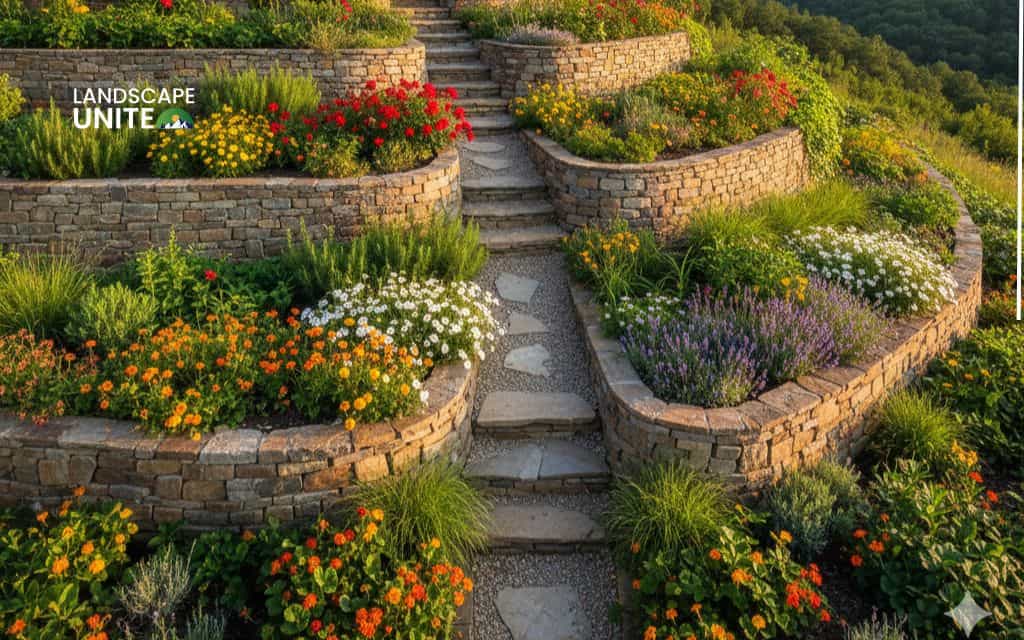
Rock garden slope
For those drawn to naturalistic landscapes or dealing with particularly challenging conditions, a rock garden slope offers a stunning, low-maintenance solution.
Combine boulders of varying sizes with gravel and hardy alpine plants. The rocks serve multiple purposes: they anchor the soil, create planting pockets with improved microclimates, add structural interest, and reduce the amount of soil exposed to erosion.
Choose plants that naturally grow in rocky, mountainous terrain: sedums, sempervivums, rock cress, alpine phlox, and saxifrages. These tough plants require minimal care once established and often provide brilliant color displays.
Best for drought-prone regions or homeowners seeking truly low-maintenance landscapes.
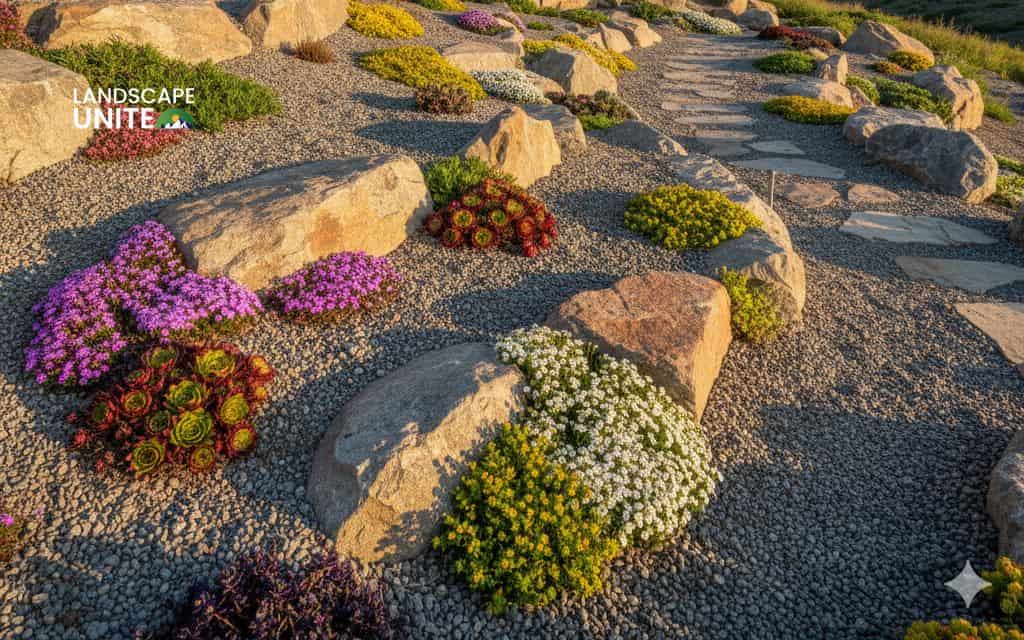
Ground cover paradise
For steep slopes where traditional flower beds would be impractical, ground covers offer an elegant, practical solution.
Replace traditional flowers with spreading ground covers like creeping thyme, sedum varieties, vinca minor (periwinkle), or ajuga (bugleweed). These plants grow horizontally rather than vertically, their roots forming dense mats that lock soil in place while their foliage coverage prevents erosion.
The beauty of ground covers extends beyond erosion control. Many bloom profusely – creeping thyme produces carpets of purple flowers, ajuga offers blue or purple spikes, and sedum provides late-season blooms when little else is flowering.
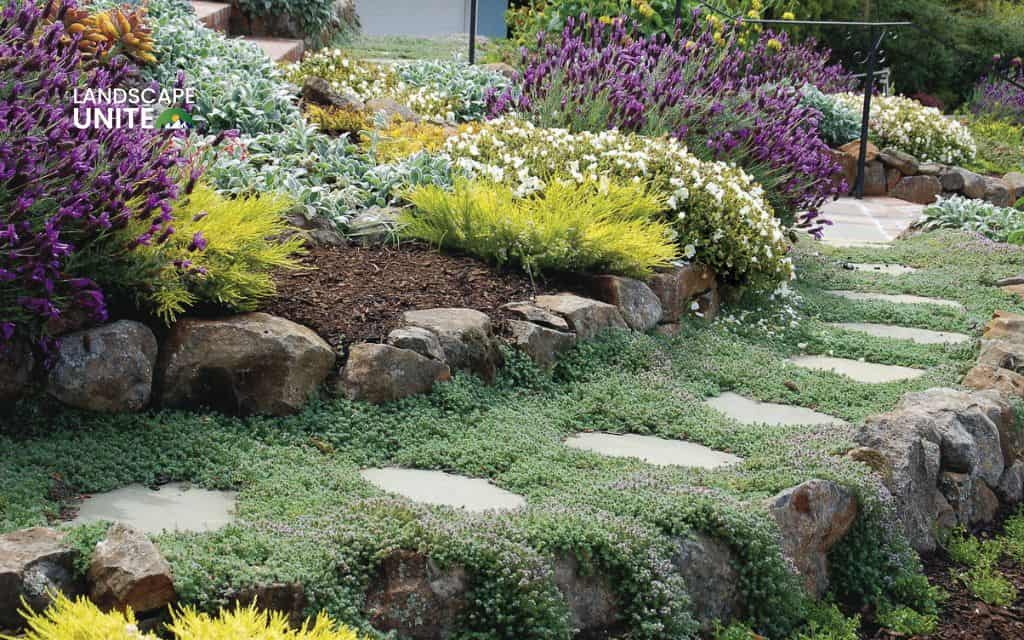
Wildflower meadow slope
Transform your hillside into a naturalistic meadow that dances with color, attracts pollinators, and requires no maintenance once established.
Mix native wildflowers suited to your region’s climate and soil conditions. Native species have deep root systems adapted to local conditions, making them naturally drought-tolerant and low-maintenance and critical for butterflies, bees, and beneficial insects.
For best results, prepare the slope by removing existing vegetation, lightly roughening the soil surface, broadcasting seeds in late fall or early spring, and keeping the area moist during germination.
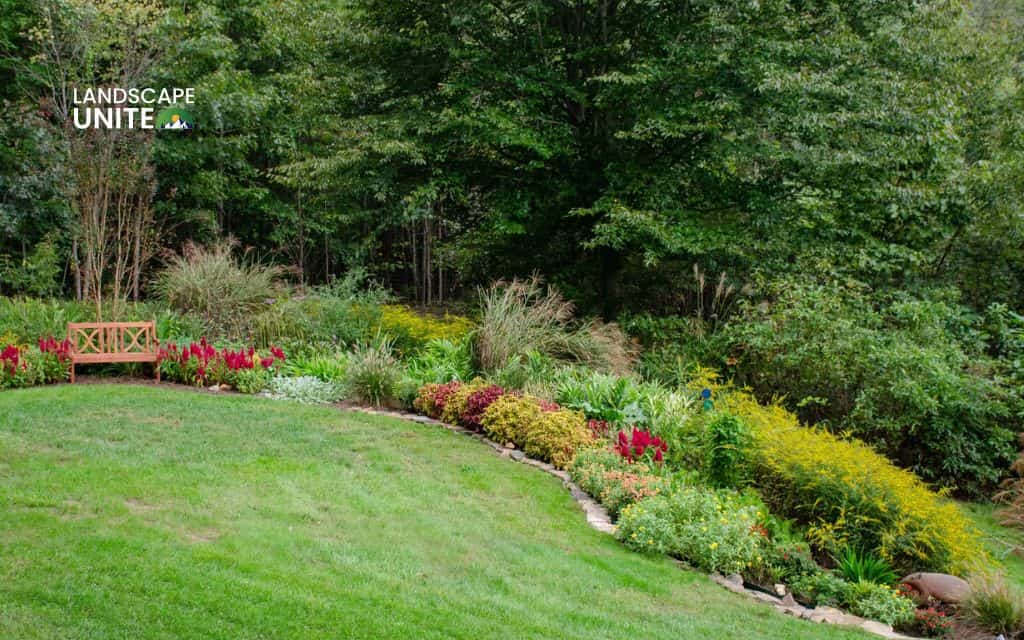
Retaining wall flower beds
Create tiered retaining walls with built-in spaces specifically designed for flowers. Many modern retaining wall systems include blocks with planting pockets, or you can leave gaps between stones in dry-stacked walls for tucking in plants.
Ideal for small yards with sharp inclines where every square foot counts. Rather than losing hillside space to maintenance difficulties, retaining walls create accessible, highly visible planting areas perfect for showcasing prized specimens or creating seasonal displays.
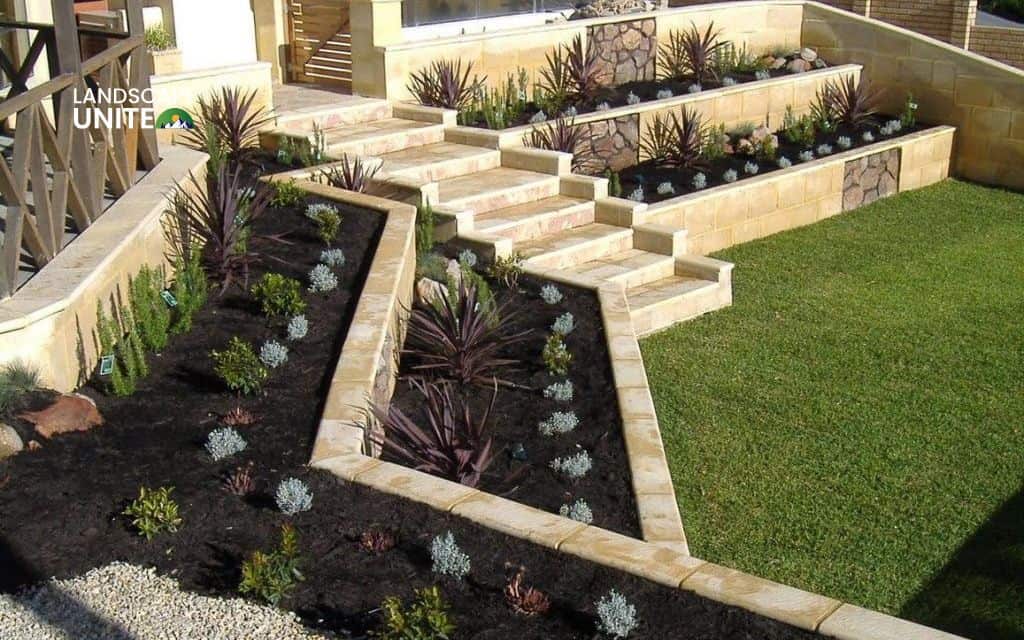
Mulched hillside garden
Cover the slope with bark mulch or wood chips (3-4 inches deep) to prevent erosion and conserve moisture. Mulch moderates soil temperature, suppresses weeds, and gradually breaks down to enrich the soil.
Add pockets of colorful perennials like daylilies, black-eyed Susans, coreopsis, or ornamental grasses at strategic intervals throughout the mulched slope. Rather than trying to plant the entire hillside, create focal points and drifts that draw the eye while keeping most of the slope simply mulched.

Cascading plants over a wall
Plant trailing flowers like creeping phlox, nasturtiums, ivy geraniums, sweet alyssum, or trailing verbena along the top edge of retaining walls or at the crest of slopes. As these plants mature, they cascade downward in sheets of color and foliage.
This technique creates a natural “waterfall” effect that softens the hard edges of walls and structures while drawing the eye through the landscape. The vertical dimension adds visual interest and makes slopes appear more dramatic and intentional.
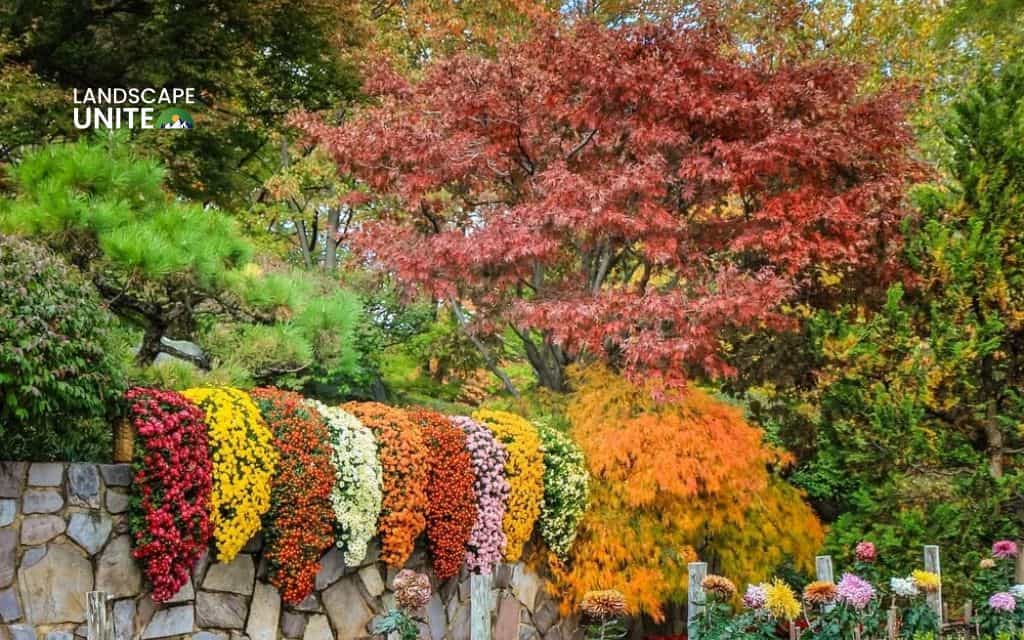
Rain garden on a slope
If water collects at the bottom of your slope or if you want to capture and filter runoff, a rain garden transforms a potential problem into an ecological asset. This reduces erosion, filters pollutants, replenishes groundwater, and creates habitat for wildlife.
Include plants that tolerate both wet conditions during rainfall events and periods of dryness between storms. Native species like blue flag iris, coneflowers (Echinacea), Joe Pye weed, switchgrass, swamp milkweed, and New England aster thrive in these fluctuating conditions.

Tiered planter boxes
Stack wooden or metal planters vertically up the slope, creating a stepped effect. This approach works well on moderate slopes adjacent to patios or decks where you want to integrate the garden with outdoor living spaces.
Planters provide complete control over soil quality and drainage – critical advantages when dealing with poor native soil or rocky slopes. Each box becomes its own contained growing environment where you can tailor amendments for specific plants.
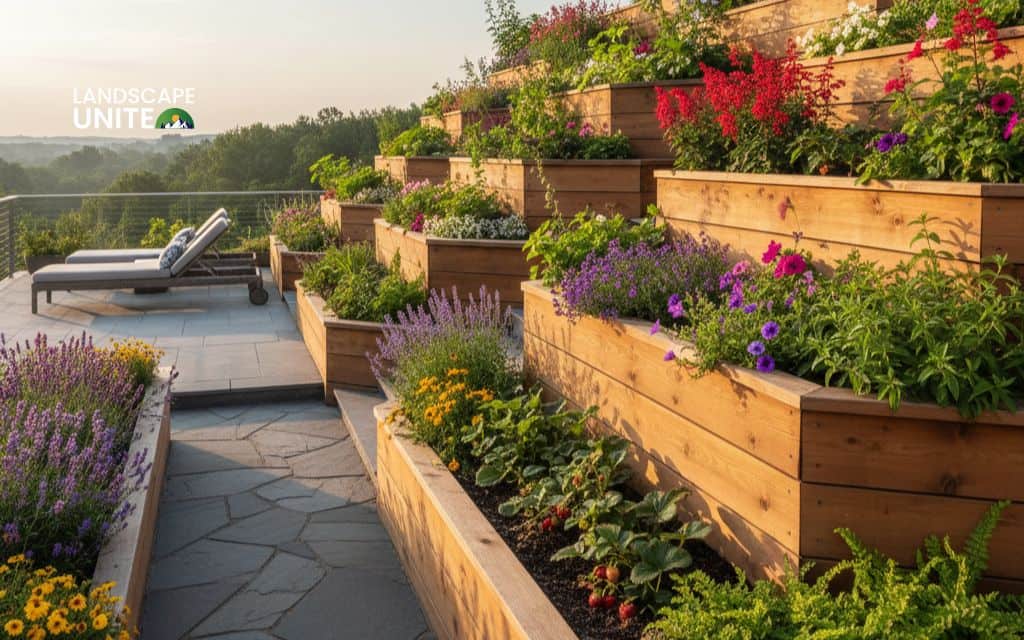
Low-maintenance xeriscape slope
For regions with water restrictions, naturally dry climates, xeriscaping transforms slopes into drought-proof showcases that thrive on neglect.
Use succulents, yucca, lavender, and ornamental grasses that have evolved to survive with minimal water. Add decorative gravel or river rocks between plants to cover the soil surface completely.
This mineral mulch eliminates weeds, prevents erosion, reflects light to brighten plantings, and creates a tidy, designed appearance with zero organic material to break down or replace.
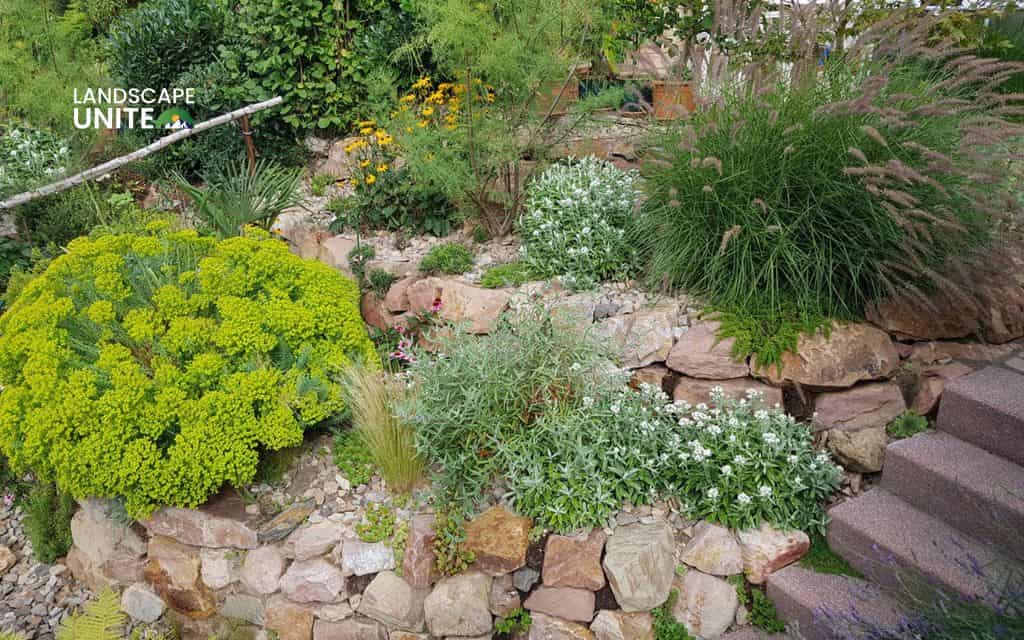
Mixed shrub and perennial design
Combine shrubs like hydrangea, spirea, barberry, ninebark, potentilla, or weigela with hardy perennials such as daylilies, Russian sage, catmint, and ornamental grasses. The woody plants provide structure and winter interest, while perennials deliver summer color and soften the landscape’s edges.
Stabilizes the slope because shrub roots penetrate deeply and spread widely, creating a permanent anchoring network. As perennials fill in between shrubs, their combined root systems form a nearly impenetrable matrix that holds soil firmly in place.
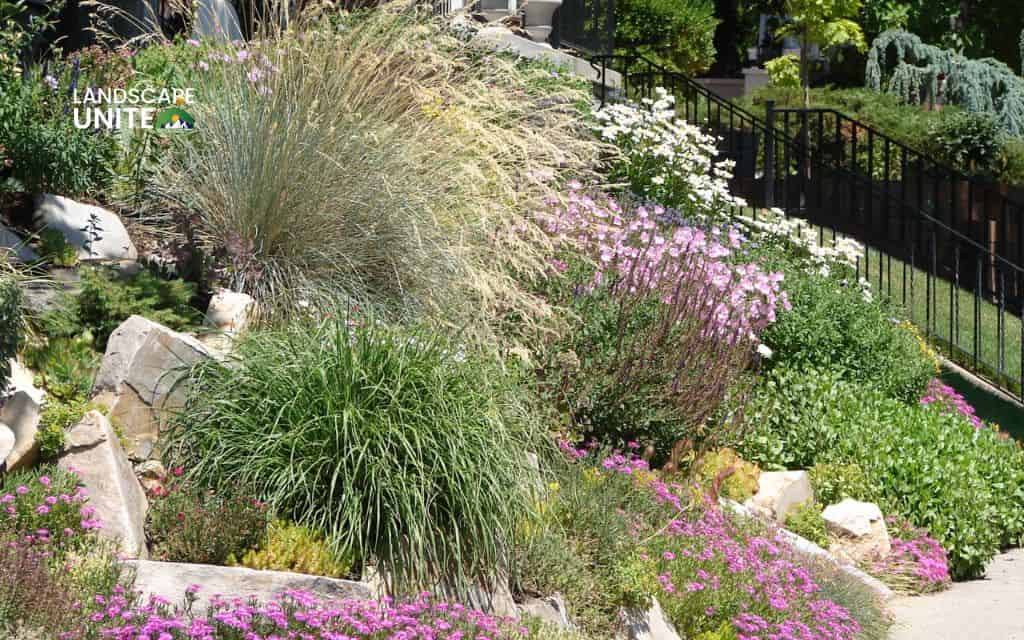
Boulder retention garden
Harness the natural beauty and functional benefits of large boulders to create a striking slope garden that appears as though it’s always been part of the landscape.
Use large boulders as natural retaining features to interrupt water flow, create level planting terraces, and add dramatic focal points. Unlike constructed retaining walls that can appear artificial, well-placed boulders blend organically with the terrain.
Plant drought-tolerant species like sedum, sempervivum, creeping juniper, ice plant, or delosperma in the crevices between and behind boulders. These tough plants thrive in the lean, rocky conditions and require virtually no maintenance once established.
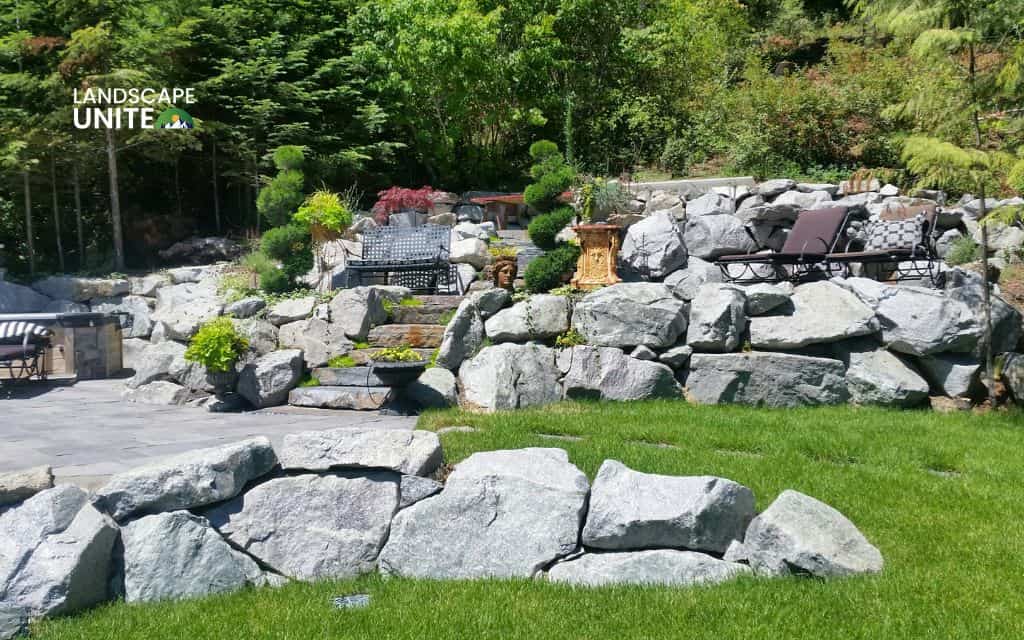
Color gradient slope
Arrange flowers by color bands, for example, darker purples and blues at the slope’s bottom, transitioning to pinks and lavenders in the middle, and finishing with whites and yellows at the top. This gradient technique creates the illusion of depth and can make slopes appear more or less steep depending on your arrangement.
Visually stretches the garden and enhances depth perception. Lighter colors recede visually, making the top of a slope appear farther away, while darker colors advance. You can manipulate these perceptions to flatter your hillside’s proportions.
This technique works with any planting style. The key is maintaining the color progression rather than mixing colors randomly throughout.
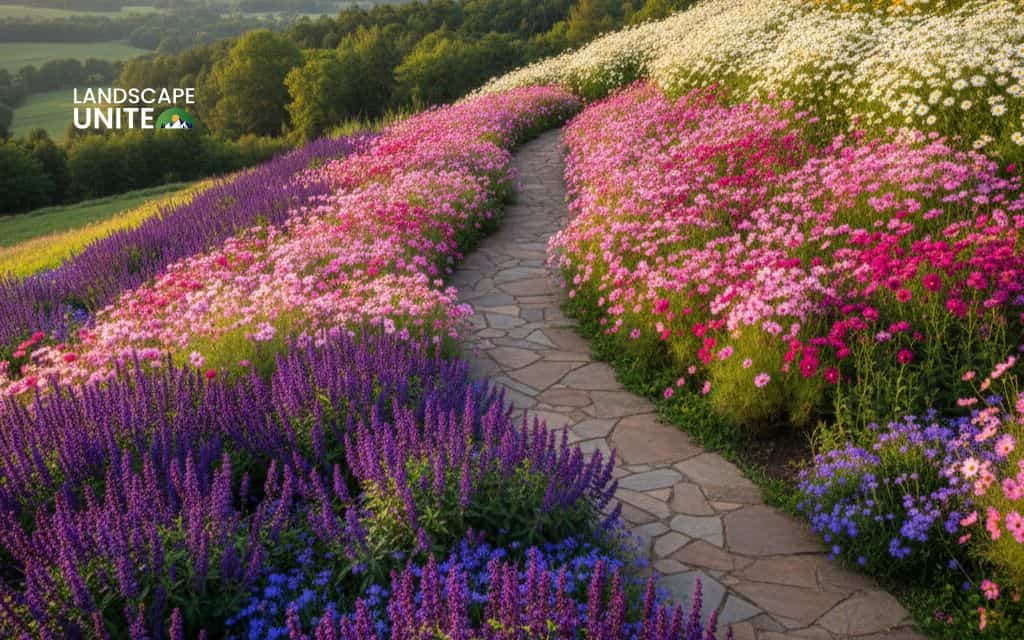
Curved bed design
Add gentle, flowing lines instead of straight tiers when designing planting beds or pathways. Curved edges appear more organic and relaxed than geometric shapes, particularly in residential landscapes where the goal is comfort rather than formality.
Softens the slope by guiding the eye smoothly through the landscape rather than creating harsh lines that emphasize the hillside’s steepness. Curves also create the illusion of space by obscuring views of the entire slope at once – each curve reveals something new.
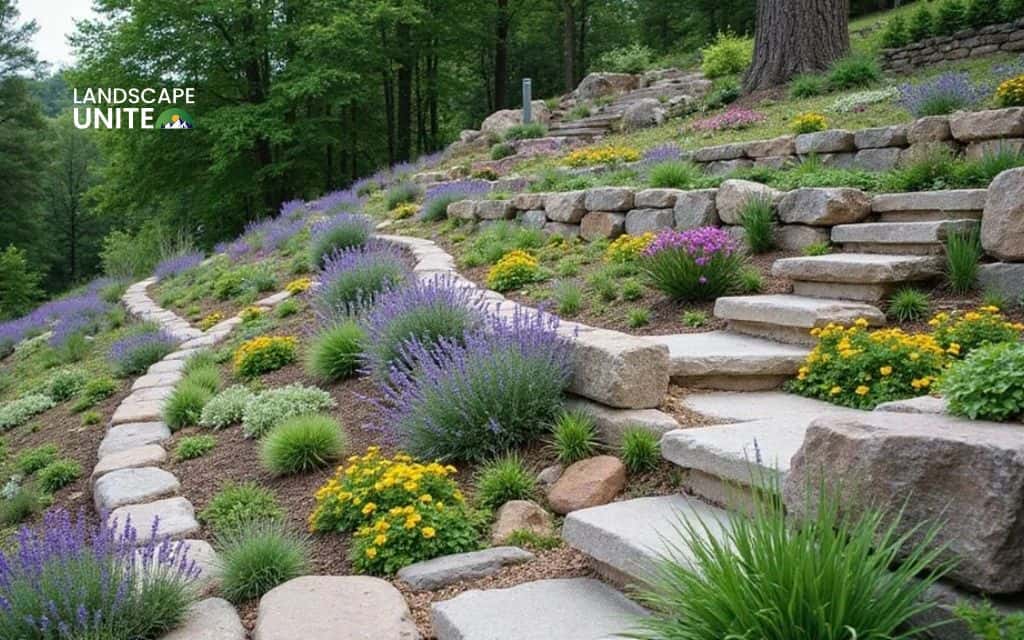
Budget-friendly log edging garden
Use fallen logs or recycled timber to create terraced planting beds or edging that holds soil in place. Logs placed horizontally across a slope create level areas behind them where plants can establish, essentially providing the function of retaining walls without the cost.
Great for rustic landscapes and DIY enthusiasts who enjoy working with natural materials and prefer organic aesthetics over manufactured products. As logs gradually decompose, they enrich the soil while providing habitat for beneficial insects and microorganisms.

Best plants for sloped flower beds
Selecting appropriate plants determines whether your slope garden thrives or struggles. The ideal candidates combine deep root systems for erosion control, drought tolerance for upper slope locations, and visual appeal throughout multiple seasons.
Perennials for slope stability
Perennials with extensive root systems anchor soil while delivering reliable color year after year. These workhorses establish quickly, spread to fill bare spots, and require minimal maintenance once mature.
- Daylilies (Hemerocallis) top the list for good reason – their thick, fleshy roots stabilize soil aggressively while their arching foliage creates year-round presence.
- Black-eyed Susan (Rudbeckia) provides cheerful yellow-gold blooms from mid-summer through fall, attracting butterflies and songbirds.
- Coreopsis (Tickseed) produces delicate, daisy-like flowers in yellows, pinks, and bi-colors on thin stems that dance in the breeze. Extremely drought-tolerant with deep taproots, coreopsis self-sows modestly to fill in gaps.
- Coneflowers (Echinacea) offer sturdy stems topped with distinctive cone-shaped centers surrounded by petals in traditional purple or modern yellows, oranges, and reds.
Ground covers
For slopes too steep to plant traditionally or areas where you want rapid coverage with minimal maintenance, these spreading ground covers deliver exceptional erosion control while creating carpets of texture and color.
- Creeping thyme (Thymus serpyllum) forms dense, low mats of aromatic foliage that withstand light foot traffic and bloom profusely with tiny purple, pink, or white flowers.
- Ice plant (Delosperma) produces succulent foliage topped with brilliant daisy-like flowers in electric purples, oranges, and yellows.
- Sedum varieties (Stonecrop) range from tiny ground-hugging species to upright forms reaching 18 inches. All share fleshy, water-storing leaves and excellent drought tolerance.
- Periwinkle (Vinca minor) creates evergreen carpets of glossy green leaves decorated with purple-blue flowers in spring.
Shrubs and small bushes
Woody plants provide permanent structure and deep root systems that stabilize slopes for decades while requiring far less maintenance than perennial gardens.
- Boxwood (Buxus) varieties offer dense, evergreen foliage that can be sheared into formal shapes or left natural for a casual appearance.
- Spirea delivers masses of flowers in spring or summer depending on variety (white, pink, or red) on gracefully arching branches.
- Barberry (Berberis) provides thorny protection against foot traffic and wildlife while offering colorful foliage ranging from burgundy to chartreuse.
- Hydrangea excels on lower slope sections or in areas with more moisture. Their spectacular blooms and substantial presence justify placement in appropriate locations.
Drought-tolerant choices
For xeriscape slopes, challenging upper slope locations, or regions with water restrictions, these tough performers survive and thrive with minimal to no supplemental irrigation.
- Agave species provide architectural drama with bold rosettes of thick, pointed leaves. Perfectly adapted to dry conditions, they store water in their leaves and require virtually no care.
- Lavender (Lavandula) combines fragrant foliage, purple-blue blooms beloved by pollinators, and excellent drought tolerance.
- Yucca species offer sword-like evergreen foliage and dramatic flowering stalks reaching 3-6 feet tall topped with creamy white bells. Incredibly low-maintenance, yuccas require no irrigation, fertilization, or pest control once established.
- Russian Sage (Perovskia) produces airy clouds of lavender-blue flowers above silvery-gray foliage on 3-4 foot stems. Exceptionally drought and heat-tolerant, it thrives in hot, sunny slope locations where other perennials struggle.
Conclusion
A slope doesn’t have to be a problem area – with the right approach, it can become the most stunning feature of your landscape. The 15 ideas in this guide offer solutions for every budget, skill level, and hillside type, from gentle inclines to steep grades.
Success starts with proper preparation: control erosion, improve drainage, and create safe access paths. Then choose techniques that match your slope’s conditions. Smart plant selection makes the difference between constant maintenance and a self-sustaining garden.
Ready to transform your hillside into a thriving garden? Explore our landscape guide library for expert advice on erosion control techniques, plant selection, and seasonal maintenance tips for sloped gardens.
Frequently asked questions (FAQs)
What is the best way to stop erosion on a slope?
Combine ground cover plants with spreading roots (like creeping thyme or sedum), add retaining walls or terracing for structural support, and apply 3-4 inches of mulch to protect soil. For steep slopes, use erosion control fabric while plants establish. Multiple methods working together provide the most effective long-term control.
What plants are best for flower beds on slopes?
Choose deep-rooted perennials like daylilies, black-eyed Susans, and coneflowers for stability. Ground covers such as creeping thyme, sedum, and vinca spread quickly to prevent erosion. For permanent structure, use shrubs like juniper, spirea, or barberry.
How can I make a sloped garden low-maintenance?
Use native plants that don’t need fertilizing or frequent watering, apply thick mulch layers to suppress weeds, install drip irrigation on a timer, and choose perennials over annuals. Ground covers eliminate mowing needs, and designing with large plant groupings reduces upkeep compared to complex mixed plantings.
Can I plant flowers on a very steep slope?
Yes, but you’ll need terracing or retaining walls to create level planting areas. Use erosion control fabric during establishment, choose plants with aggressive root systems, and ensure safe access with proper steps or pathways. Rock gardens with boulders also work well on very steep slopes.
How much does it cost to landscape a slope?
Costs range from $15–$50 per square foot depending on materials and slope steepness. Simple approaches (ground covers and mulch) cost less, while extensive terracing with stone walls costs more. Start with a small section to manage costs and expand gradually.
